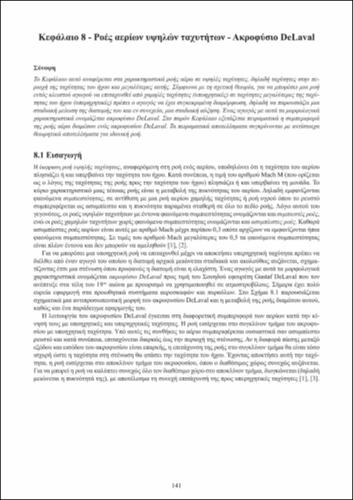| Title Details: | |
|
High-Velocity Gas Flows – DeLaval Nozzle |
|
| Authors: |
Sideridis, Georgios |
| Reviewer: |
Tsangaris, Sokratis |
| Subject: | ENGINEERING AND TECHNOLOGY > TECHNOLOGICAL SCIENCES AND ENGINEERING > MECHANICAL ENGINEERING AND TECHNOLOGY > FLUID MECHANICS ENGINEERING AND TECHNOLOGY > TECHNOLOGICAL SCIENCES AND ENGINEERING > MECHANICAL ENGINEERING AND TECHNOLOGY > PUMPS AND LIQUID HANDLING EQUIPMENT ENGINEERING AND TECHNOLOGY > TECHNOLOGICAL SCIENCES AND ENGINEERING > MECHANICAL ENGINEERING AND TECHNOLOGY > HYDRAULIC TURBOMACHINES |
| Description: | |
| Abstract: |
This Chapter refers to the characteristics of airflow at high speeds, i.e. speeds in the range of the speed of sound and higher. According to the relevant theory, for a flow in a closed pipe to accelerate from low (subsonic) velocities to supersonic velocities, the pipe must have a specific configuration, i.e. show a gradual reduction in its cross-section and then a gradual increase. A pipe with these morphological characteristics is called a DeLaval nozzle. In this Chapter, the behavior of airflow through a DeLaval nozzle is examined experimentally. The experimental results are compared with corresponding theoretical results for ideal flow.
|
| Linguistic Editors: |
Kalliaras, Dimitris |
| Technical Editors: |
Loukeri, Sofia |
| Graphic Editors: |
Kouli, Christina |
| Type: |
Chapter |
| Creation Date: | 2015 |
| Item Details: | |
| License: |
http://creativecommons.org/licenses/by-nc-nd/3.0/gr |
| Handle | http://hdl.handle.net/11419/4190 |
| Bibliographic Reference: | Sideridis, G. (2015). High-Velocity Gas Flows – DeLaval Nozzle [Chapter]. In Sideridis, G. 2015. Laboratory Exercises in Fluid Mechanics [Laboratory Guide]. Kallipos, Open Academic Editions. https://hdl.handle.net/11419/4190 |
| Language: |
Greek |
| Is Part of: |
Laboratory Exercises in Fluid Mechanics |
| Publication Origin: |
Kallipos, Open Academic Editions |

